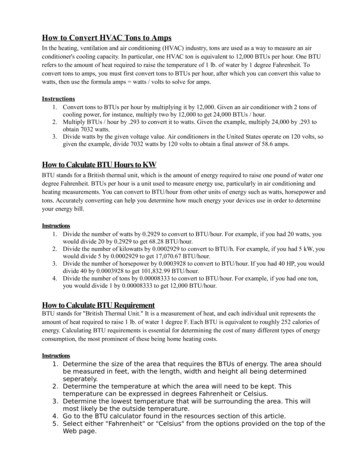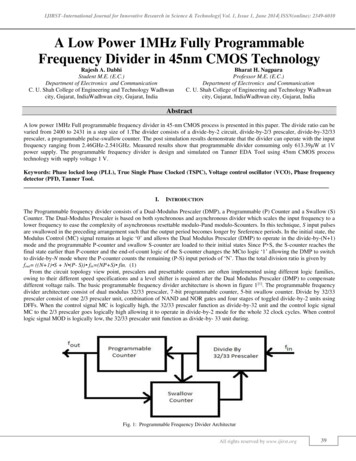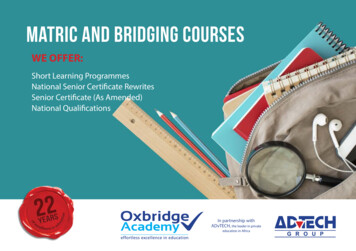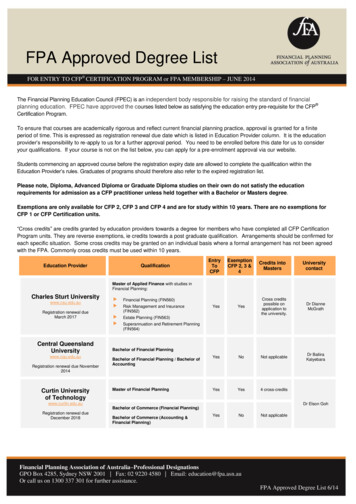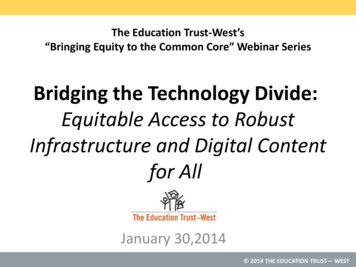
Transcription
The Education Trust-West’s“Bringing Equity to the Common Core” Webinar SeriesBridging the Technology Divide:Equitable Access to RobustInfrastructure and Digital Contentfor AllJanuary 30,2014 2014 THE EDUCATION TRUST— WEST
Education Trust-West Staff Jeannette LaFors, Director of EquityInitiatives Amber Banks, Practice Associate Orville Jackson, Senior Research Analyst 2014 THE EDUCATION TRUST— WEST
Housekeeping This webinar slide deck and recording willbe archived on our website We encourage you to ask questionsthroughout the webinar via “Questions” If you are having any technical difficultiesyou can call GoToWebinar at 800-259-3826or chat with tech support online 2014 THE EDUCATION TRUST— WEST
Poll:Who is on the webinar? 2014 THE EDUCATION TRUST— WEST
About Us: The Education Trust- WestPolicy &ResearchPracticeAdvocacyOUR MISSION: The EducationTrust-West works for the highacademic achievement of allstudents at all levels, pre-kthrough college. We exposeopportunity and achievementgaps that separate studentsof color and low-incomestudents from other youth,and we identify and advocatefor the strategies that willforever close those gaps. 2014 THEEDUCATIONTRUST— WEST 2014THE EDUCATIONTRUST
Goals of the Webinar1. Engage digital equity thought leaders indiscourse about key issues related toCommon Core2. Learn about promising practices forpromoting digital equity3. Reflect on digital equity in your schooland/or district 2014 THE EDUCATION TRUST— WEST
Agenda1. Overview & Context2. Digital Equity & Infrastructure3. Implementing Blended Learning Models with Equityin Mind4. Questions and Closing 2014 THE EDUCATION TRUST— WEST
Today’s Panelists Evan Marwell, CEO, EducationSuperHighway Brian Simmons, Director of Accountability,Innovation and Results, San Mateo County Officeof Education Chris Florez, Manager of Digital Learning, AspirePublic Schools (Tennessee) Elena Sanina, Blended Learning Analyst, AspirePublic Schools (California) Bernadette Lucas, Director, LAUSD CommonCore Technology Project 2014 THE EDUCATION TRUST— WEST
Common Core Digital Equity nts 2014 THE EDUCATION TRUST— WEST
Building a Coherent Vision for Digital EquityCurriculumAssessmentInstructionThe opportunity to build a vision for digital equity in schools anddistricts lies at the intersection between the adoption of newcurricula and the implementation of new standards andassessments. 2014 THE EDUCATION TRUST— WEST
What is Digital Equity in an Era of Common Core*?*see resources page for citationDIGITALEQUITYCapacitySelectionProfessional LearningPDCollaborationMonitoringTechnical AssistanceSelection & Set UpTroubleshootingMaintenance 2014 THE EDUCATION TRUST— WEST
Digital Equity: Benefits and RisksBenefitsGreater access to digital learningtools and mediaRisksDigital Divide (i.e. access)Engagement with rigorousQuality Gapcontent and opportunities to build Digital Literacy Gapdigital literacy skillsMore opportunities forpersonalization using real-timedataLimited Teacher CapacityEquity issues will continue to focus onaccess and distribution of critical resources 2014 THE EDUCATION TRUST— WEST
Poll:What are your most pressing concernsrelated to digital equity in yourschool/district/community? 2014THE EDUCATION 2014 THEEDUCATIONTRUST—TRUSTWEST
Evan Marwell, CEO, EducationSuperHighwayBrian Simmons, Director, Accountability, Innovation, Results, SanMateo County Office of Education 2014 THE EDUCATION TRUST— WEST
EducationSuperHighwayAmerica’s Leading Non-Profit for K-12 Internet InfrastructureMission: Upgrade the Internet infrastructure of every K-12 publicschool in America for digital learningIdentifySchoolsRequiringUpgradesHelp DistrictsCreate UpgradePlansLower the Costof Connectivity& EquipmentSupport E-RateModernizationE-Rate2.0Network SnapshotInternet PricingPortalEducationSuperHighway15 2014 THE EDUCATION TRUST— WEST
Potential Network BottlenecksEducationSuperHighway16 2014 THE EDUCATION TRUST— WEST
State of the NationDigital Learning Readiness80%72%70%60%50%40%27%30%20%10%1%0%Not Ready For Digital LearningReady For Digital Learning (2013)Ready For Digital Learning (2017)Source: EducationSuperHighway National SchoolSpeedTest – Interim ResultsDigital Learning Readiness Based on SETDA Standard: 100kbps/student (2013); 1 Mbps/student (2017) 2014 THE EDUCATION TRUST— WEST
State of the NationOnline Assessment Readiness40%35%34%33%33%Ready For Basic Assessment (2050kbps/student)Ready For Media Rich Assessment( 50kbps/student)30%25%20%15%10%5%0%Not Ready For Online Assessment( 20kbps/student)Source: EducationSuperHighway National SchoolSpeedTest – Interim Result 2014 THE EDUCATION TRUST— WEST
State of the NationThe median school will have to increase its spending on broadband connectivity by 9x to meet the2017 digital learning standards. Cost reduction is an imperative – and is possible.Cost of ConnectivityCost per Megabit per Month 30 25 24.5 20WAN 15Internet Access 10 5 2.1 MedianTop Quartile 2014 THE EDUCATION TRUST— WEST
San Mateo County Infrastructure Assessment SchoolSpeedTest – simple web-based measurement ofavailable bandwidth 45% of schools ready for digital learning 80% of schools ready for media rich assessment Network Snapshot – in-depth interviews with district ITdirectors and on-site visits Detailed infrastructure assessment to identifynetwork bottlenecks Internet Pricing Portal – analysis of broadband andtelecommunications costs using E-Rate data Significant variability in prices paid Specific opportunities to lower costs by adoptingapproaches of best practice districts 2014 THE EDUCATION TRUST— WEST
San Mateo County Network Snapshot ResultsDistrict NameUpstream/ISPWANWi-FiSequoia Union HighLas LomitasReady fordigitallearningMenlo Park CityRedwood CityRavenswoodBelmont-Redwood ShoresSan CarlosSan Mateo Union HighUpgrade plannedBurlingameBottleneckedBrisbane ElementaryN/APortola ValleyN/AJefferson UnionHiddenbottlenecksSan Mateo-Foster CityLow devicesPacificaLow devicesMillbrae ElementaryLow devicesHillsborough CityUpgrade plannedJefferson Elementary802.11gSan Bruno ParkSouth San FranciscoAvailabilityconstraintsCabrillo UnifiedLa Honda-Pescadero UnifiedN/A 2014 THE EDUCATION TRUST— WEST
iZone San Mateo CountyEd Trust West Webinar – January 30, 2014 2014 THE EDUCATION TRUST— WEST
The Opportunity: The Perfect StormThe Digital PromiseAllows us to create personalizedlearning opportunities for everystudentNationwide Standard45 states will be adopting CommonCore as a standard by 2014/2015AnneGeddes 1.25B in CaliforniaWill be allocated for CommonCore implementation and schoolsmay choose how to direct fundsThe Glaring Problem 2014 THE EDUCATION TRUST— WEST
The Challenge: Are we ready?Digital DivideMany students don’t havesufficient infrastructure or accessto instructional technology forCommon Core assessments, letalone Digital LearningFragmentationSchools, districts, business,government and advocacygroups need alignment. 170 per studentNot enough to manage thetransition to the Common Core 2014 THE EDUCATION TRUST— WEST
Good News: Great Initiatives Already Underway Educators are thinking & acting bothoutside of the box & collectively withexternal partners– The Big Lift – early literacy– Cross-grade span articulation: 8th/9thGrade Math transition– Safe & Supportive Schools/Communities– Adolescent Mental health “EdTech” Providers are creating newsolutions Students are inspiring us bypioneering technology outside of class Districts are empowered with newflexibility in resource allocation and arenewed commitment to engagement25 2014 THE EDUCATION TRUST— WEST
The iZone MissionBuild shared capacity across schools, districts and communities toaccelerate transformation of education for the digital ping educatorsincubate and acceleratenew teaching and learningmodels, toolsand practiceshelping educatorsprovide equitable learningopportunities for all studentswith a focus on closing theachievement gaphelping educatorspersonalize instruction andcreate engaging, studentcentered learning in andbeyond the classroom26 2014 THE EDUCATION TRUST— WEST
Areas of FocusTeams execute on opportunities to transform instruction andlearning environments at scale by focusing on:Learning &LeadershipDev.PublicPolicyTools,Models s &Assessment27 2014 THE EDUCATION TRUST— WEST
So What is the iZone? A network of innovators who will collaborate and sharelearning Facilitation of a process of innovation An organized set of partnerships supporting innovations inthe network28 2014 THE EDUCATION TRUST— WEST
Infrastructure and Learning Analytics 2014 THE EDUCATION TRUST— WEST
Partnerships: Education Superhighway Resource procurementefforts underwayDesign Thinkingengagements underway tounderstand the hierarchy ofneeds and a bottom-upapproach to resourceallocationCross-sector partnerships30 2014 THE EDUCATION TRUST— WEST
Partnerships: Silicon Valley Community Foundation SVCF is supporting our workto establish a Common CoreState Standards-alignedLearning Analytics Centerfor San Mateo County Our collaborative (SMCOE& 9 districts) have receiveda 400k grant over threeyears.31 2014 THE EDUCATION TRUST— WEST
What’s next? Continued focus on the role of innovation in closing theachievement gap (with both technology and non-technicalsolutions) Partnership development Resource procurement Continued refinement of innovation blueprint among designteams32 2014 THE EDUCATION TRUST— WEST
www.aspirepublicschools.orgChris Florez, Manager of Digital LearningElena Sanina, Blended Learning Analyst
Aspire Public Schools - Overview California’s highest-performing, high-poverty K12 school system Large scale and top-tier results– Over 13,000 students in 37 schools in 10 cities– Currently expanding in Memphis, TN: 2 Pre-K – 5th grade schools in 2013-2014adding one grade per year (pre-K-8) 1 Pre-K – 5th grade opening in 2014-2015 All three are Blended models– Plan to serve another 5,600 students within 5 years– As we’ve grown, our API scores have increased Our kids go to college– For the last two years, 100% of our graduatingseniors accepted to four-year colleges– High quality teachers lead to student achievement Efficient, scalable financial model– Minimal private funds leveraged for public funds
Our SchoolsBay AreaOakland Aspire Berkeley Maynard Academy (K-8) Aspire California College PreparatoryAcademy (9-12) Aspire College Academy (K-5) charter sharedwith California College Prep Academy Aspire ERES Academy (K-8) Aspire Golden State Prep Academy (6-12) Aspire Lionel Wilson College PreparatoryAcademy (6-12) Aspire Millsmont Academy (K-5) Aspire Monarch Academy (K-5)East Palo Alto Aspire East Palo Alto Charter School (K-6) Aspire East Palo Alto Phoenix Academy (7-12)Los Angeles Aspire Antonio Maria Lugo Academy (K-5)Aspire Centennial College PreparatoryAcademy (6-7)Aspire Firestone Academy (K-5)Aspire Gateway Academy (K-5)Aspire Huntington Park Charter School (K-5)Aspire Inskeep Academy (K-6)Aspire Junior Collegiate Academy (K-5)Aspire Pacific Academy (10-12)Aspire Slauson Academy (K-6)Aspire Tate Academy (K-6)Aspire Titan Academy (K-5)Aspire Ollin Academy (7-9)Central ValleySacramento Aspire Alexander Twilight College PreparatoryAcademy (K-5) Aspire Alexander Twilight SecondaryAcademy (6-11) Aspire Capitol Heights Academy (K-5)Stockton Aspire APEX Academy (K-5) Aspire Benjamin Holt College PreparatoryAcademy (6-12) Aspire Langston Hughes Academy (6-12) Aspire Port City Academy (K-5) Aspire River Oaks Charter School (K-5) Aspire Rosa Parks Academy (K-5) Aspire Vincent Shalvey Academy (K-5)Modesto Aspire Summit Charter Academy (K-5) Aspire University Charter School (K-5) Aspire Vanguard College PreparatoryAcademy (6-12)Memphis Aspire Hanley 1Aspire Hanley 2
Our Blended Learning Model Designed with Students & Teachers in MindNo need to develop additional workstation contentNo need to grade additional activities/assessmentReal-time data and analytics provided for teachersAligned to Common Core State StandardsMore time to spend on targeted instruction with students:one-on-one and small groups Consistent time on activities to support learning, planning, andinstruction More than Computers in a Classroom Personalized, adaptive Math & ELA instruction Meet all students on their individual learning paths Opportunities to learn and apply concepts in different modalities
Grades K – 5 convert to a classroom rotation modelIn the classroom, each studentwill have:PersonalizedOnlineInstructionTeacher LedSmallGroupInstructionIndependent &CollaborativePractice 30 minutes of literacy on computersdaily 30 minutes of math on computers daily Targeted guided reading lessondaily A classroom structure that supportsteacher development as a smallgroup lesson planner and executor A school with a changing culture thatwill focus even more on individualizedinstruction, learning, and achievement
Blended Learning Pilot Overview - CAAspire Millsmont Academy K-5 Conversion began 2013-14 Lab rotation modelAspire ERES Academy K-8 Conversion began 2011-12Aspire Titan Academy K-5 Conversion began 2012-2013OaklandHOAspire Gateway Academy K-5 Conversion began 2014Aspire Tate Academy K-6 Conversion began 2014Aspire Inskeep Academy K-6 Conversion began 2014Aspire Slauson Academy K-6 Conversion began 2014
Blended Learning:CODE AspireBlended Learning Pilot Overview - MemphisElementary GradesScience Lab Rotation Model:6th – 8th GradeSTEM Program:50 minute instructional block every other day for 3rd – 5thgrade students.Project-BasedIn-Class Science Instruction:Science/Math & HumanitiesThematic UnitsAll K-5 students 40 minute block per week. 3-5 aligned withScience Lab instruction, informational text, writing.Problem-Based3 Years of Coding (Programming)Technology Rotation Model:50 minute instructional block for all K-5 students. UtilizesEasyTech software for adaptive, assignable, individualization.1:1 Student-to-DeviceExploring Tablets (Cost and DL)Maintain Flexible Groups forBlended Learning RotationsCoding & Robotics:Afterschool program for 4th - 5th grade students.Tynker/Scratch in Technology Lab 2x week for 1 hoursessions. NXT robotics on Friday afternoons for 2 hours.Hour of Code in December for all students.3
CODE Aspire: MemphisBlended Learning Laptop StationLaptops are permanently locked and powered at tables.Laptops imaged with program shortcuts on desktop.Additional (offline) software installed: Scratch, Kodu, Google SketchUp, Rapid Typing, Office Individual headphones are stored in reusable laptop cartons at tables.
Technology Integration & Blended Learning Students & Teachers Recognize Value:Relationships, Rigor, Student Ownership, Individualization Personal Achievement:Online learning provides safe, personal space for students to struggle andfind success Common Core Alignment Maintain Integrity of Existing Instructional Program Provide More Opportunities for Small Group &Individualized Instruction: Adaptive & Assignable Increased Data Access & Usability Digital Literacy Development
Is Every Classroom Ready for Tech?Blended Learning Readiness Document3
Why Technology, Why Blended?Meet Josephine*, a 5th grade student at CODE AspireBecause she’s at CODE Aspire, Josephine: Receives individualized, online ELA instruction Receives individualized, online Math instruction Has teachers who utilize multiple data points to inform instruction Has teachers who meet weekly to collaborate and share best practices Participates in daily, targeted, guided reading lessons Has clear learning expectations based on Common Core State Standards Has enrichment courses in Science and Technology Leads her afterschool Robotics team Is teaching her little brother how to code using KidsRuby*Josephine is an illustrative, not actual, Aspire student.
Collaboration Across the Regions Hardware and Software Recommendations Professional Development Resources for Teachers(How to launch and support our Blended Learning model) Data Warehouse & Usability(Growth Comparison & Variable Considerations) Site-Based Newsletters Account Provisioning Vendor Relations
Questions
The LAUSD Common Core Technology ProjectBernadette Lucas, .lausd.net
Number of Devices Deployed Per Week 30,000Number of Devices Deployed per Week23,771Number of Device Deployed25,00022,160 482Aug. 26Sept. 9Sept.16Sept. 23Sept. 30Oct. 7Oct. 14Oct. 21Nov. 4Number of Devices Deployed per WeekTotal Number of Devices Deployed
Leading Change that Impacts Equity and Accessfor All Students Deploying to over 25, 000Ensuring quality professional developmentEstablishing systems and protocols that capture and honor the voiceof students, teachers, site administrators, support staff, and parents Implementing a communications plan that speaks to thestory and purpose of the project Designing and implementing a coordinated plan that meet the needsof ALL students including: English Learners, identified-giftedstudents, advanced learners, identified-students with special needs
Timeline
Project StakeholdersTeachers &School SiteAdministratorsThe Public/VotersVendors &OtherPartnersStudentsMedia &CommunicationsParents
Q&A 2014 THE EDUCATION TRUST— WEST
Poll:To what extent did we reach our goals forthe webinar today?1. Engage digital equity thought leaders indiscourse about key issues related toCommon Core2. Learn about promising practices forpromoting digital equity3. Reflect on digital equity in your schooland/or district 2014THE EDUCATION 2014 THEEDUCATIONTRUST—TRUSTWEST
THANK YOU! 2014 THE EDUCATION TRUST— WEST
RESOURCES EducationSuperHighwaySan Mateo County Office of EducationAspire Public SchoolsLAUSD Common Core Technology ProjectUS Department of Education ConnectED ProgramUS Department of Education E-Rate ProgramEdWeek, Jan 14, 2014 “Districts Get Creative To BuildFaster Internet Connections” Core Education Limited, “Submission to the Inquiry into21st century learning environments and digital literacy.”May 2012* See Slide 11 2014 THE EDUCATION TRUST— WEST
through college. We expose opportunity and achievement gaps that separate students . with California College Prep Academy Aspire ERES Academy (K-8) Aspire Golden State Prep Academy (6-12) Aspire Lionel Wilson College Preparatory Academy (6-12) Aspire Millsmont Academy (K-5) Aspire Monarch Academy (K-5) East Palo Alto


